Hubble’s Variable Nebula is a variable nebula located approximately 2,500 light-years away in the constellation Monoceros. It is illuminated by the young variable star R Monocerotis. The nebula lies in the same region as the Cone Nebula and the Christmas Tree Cluster. It has the designation NGC 2261 in the New General Catalogue.
NGC 2261 is a fan-shaped reflection nebula that stretches about 1 light-year across. In small and medium telescopes, it looks like a small comet. The brightness and shape of the nebula slowly change over periods of weeks and months. Astronomers believe that the variability comes from dense knots of dust that pass close to R Monocerotis and cast moving shadows on the nebulosity that reflects the star’s light.
Hubble’s Variable Nebula was captured by the Hubble Space Telescope in 1999. Like the space telescope, it was named after the American astronomer Edwin Hubble, who studied it extensively in the early 20th century.
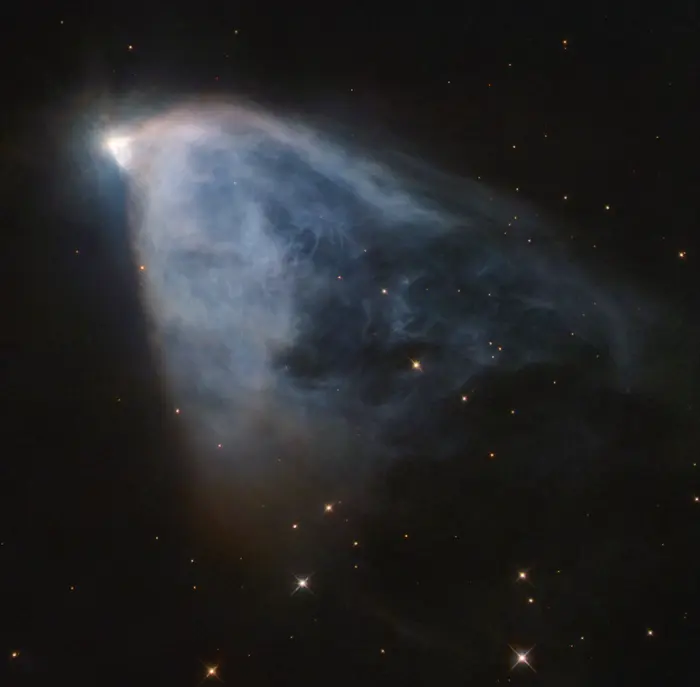
Hubble’s Variable Nebula (NGC 2261), image credit: NASA, ESA, Judy Schmidt (CC BY 2.0)
The nebula lies within a small, elongated cloud. Observations in 1981 suggested that the strong stellar wind of R Monocerotis created a bipolar cavity in the cloud, with blueshifted emission to the north and redshifted emission to the south. Astronomers interpreted this as NGC 2261 shining in light reflected from the cavity walls in the northern outflow. In other words, the blueshifted outflow has carved out the molecular cloud north of R Monocerotis, created the reflection nebula and filled it with high-velocity gas.
Astronomers also detected a small cloud of faint nebulosity about 7 arcminutes north of R Monocerotis, where the outflow becomes visible as a Herbig Haro object. The Herbig-Haro object is catalogued as HH 39. HH 39 appears reddish in images and shows strong emission lines of hydrogen and nitrogen. It is believed to be energized by a strong outflow from R Monocerotis.
In 2020, images obtained with the Atacama Pathfinder Experiment (APEX) radio telescope in Chile and older images captured by the SPIRE instrument aboard the Herschel Space Observatory confirmed that there is a region free of dust emission between the HH 39 cloud and the R Monoceros cloud. Additionally, the astronomers found that HH 39 is not on the symmetry axis of the outflow.
A group of amateur astronomers at the Big Amateur Telescope captured a timelapse of Hubble’s Variable Nebula from October 2021 to April 2022. The video shows gas being emitted outwards.
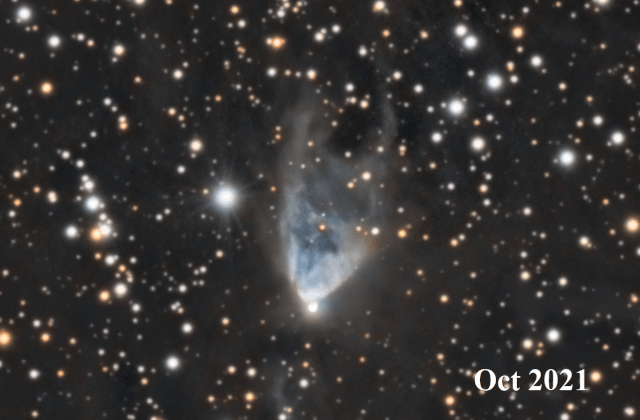
A timelapse of NGC 2261 from October 2021 to April 2022, image credit: Big Amateur Telescope, Wikimedia Commons/Jackforlife101 (CC BY-SA 4.0)
R Monocerotis
R Monocerotis is a young binary star that illuminates Hubble’s Variable Nebula. The star has the spectrum of a hot blue giant of the spectral type B8IIIev. However, it is still a young stellar object, a pre-main sequence star that has not yet started to fuse hydrogen in its core. It is still accreting material from its birth cloud.
R Monocerotis is a Herbig Ae/Be star, a massive pre-main sequence star still embedded in an envelope of dust and gas. It has a circumstellar disk that extends to a distance of under 150 astronomical units from the star.
The star has a companion, a T Tauri star (a pre-main sequence star with a mass of up to 3 solar masses), at a separation of 0.69 arcseconds.
R Monocerotis lies 2,600 light-years away and has an apparent magnitude that varies between magnitude 10 and 12. It is not visible directly because its light is obscured by the surrounding dust with 13.1 magnitudes of extinction, but it can be observed in the infrared.
The star has an estimated mass between 2 and 10 times that of the Sun and it is believed to be around 100,000 years old. It has a bolometric luminosity under 1,000 times that of the Sun. The star is still actively accreting material, which accounts for a good fraction of the observed luminosity.
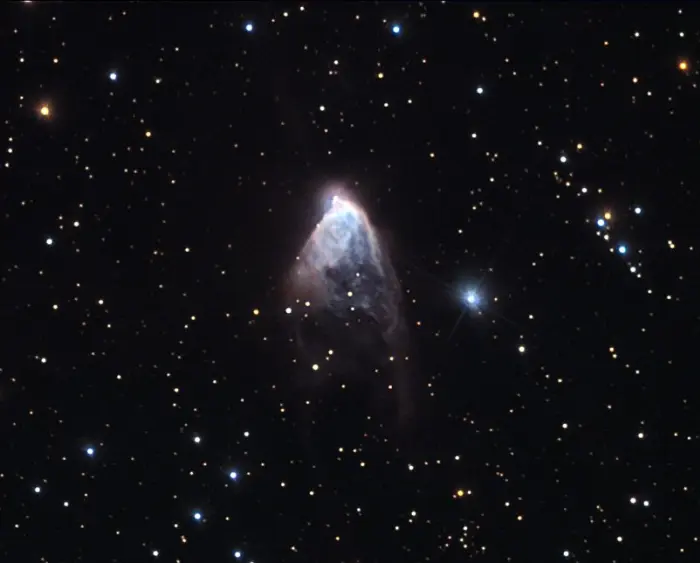
Comet!? No- this object was put into the correct category as a diffuse nebula. The bright star at the tip of the cloud of gas is called R Monocerotis. It is a variable star that is actually in the background of the cloud of gas. The gas cloud is around 1 light year in extent and due to the variability of R Mon, the entire nebula changes in its brightness. However, R Mon is mysterious because the mechanism of its variations is uncertain. The most accepted explanation is that there exist clouds of gas and dust very close to R Mon and these clouds eclipse R Mon (as they orbit about it) casting shadows onto the foreground nebula. This image was taken as part of Advanced Observing Program (AOP) program at Kitt Peak Visitor Center during 2014. Image credit: KPNO/NOIRLab/NSF/AURA/Carole Westphal/Adam Block (CC BY 4.0)
Facts
Hubble’s Variable Nebula was first recorded by the German-born British astronomer William Herschel on December 26, 1783. Herschel described the nebula as “fan-shaped” and listed it as H IV 2 in his catalogue of nebulae.
NGC 2261 was named after the American astronomer Edwin Hubble, who discovered its variability. Hubble studied the nebula at Yerkes Observatory in Wisconsin and at the Mount Wilson Observatory in California. In a paper published in The Astrophysical Journal in October 1916, he reported changes in the nebula’s outline and displacements of structural details. He noticed the variations after comparing an image he had taken at Yerkes Observatory to ones captured by F. C. Jordan in March 1908 and Isaac Roberts in January 1900.
On January 26, 1949, Hubble was the first astronomer to use the newly built Hale Telescope, a giant 200-inch reflector at the Palomar Observatory near San Diego, California. He chose NGC 2261 as the first target.
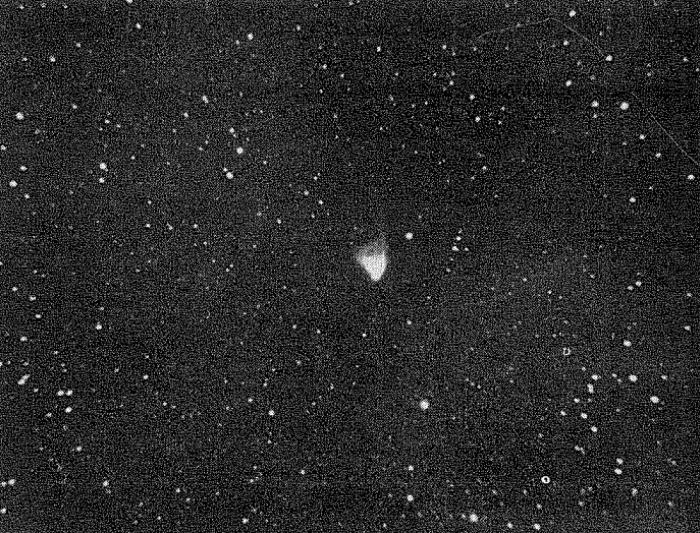
Hubble’s Variable Nebula captured by the Hale Telescope in 1949.
Hubble’s Variable Nebula is one of two young variable nebulae listed in Sir Patrick Moore’s Caldwell catalogue of objects visible in amateur telescopes. It has the catalogue designation Caldwell 46. The other variable nebula is the R Coronae Australis Nebula (Caldwell 68), a variable reflection and emission nebula located in the southern constellation Corona Australis.
Hubble’s Variable Nebula (NGC 2261) is not to be confused with Hind’s Variable Nebula (NGC 1555), a variable nebula illuminated by the young stellar object T Tauri. Hind’s Variable Nebula lies 400 light-years away in the constellation Taurus and appears near the Hyades cluster in the sky. It is named after the English astronomer John Russell Hind, who discovered it in October 1852.
Location
Hubble’s Variable Nebula is relatively easy to find even though it lies in the faint equatorial constellation of Monoceros (the Unicorn). It lies just outside the Winter Triangle, a bright asterism formed by Sirius in Canis Major, Betelgeuse in Orion, and Procyon in Canis Minor.
Hubble’s Variable Nebula appears along the imaginary line extended from Alhena in Gemini to Sirius, just north of the line connecting Betelgeuse and Procyon. It can be spotted in large binoculars or small telescopes in good conditions.
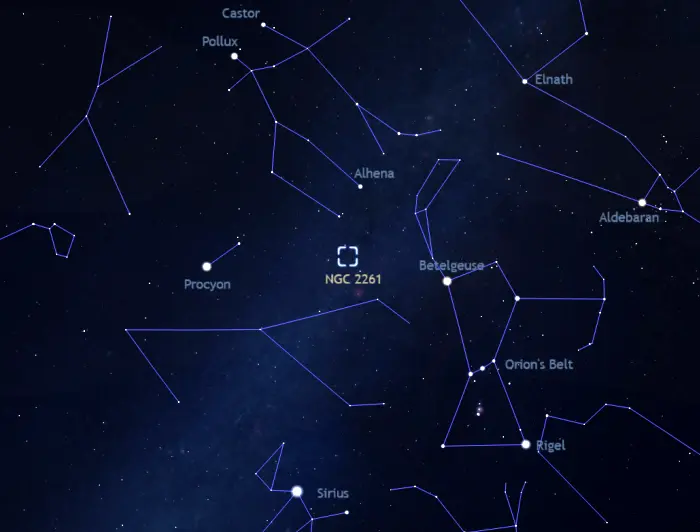
The location of Hubble’s Variable Nebula (NGC 2261), image: Stellarium
The nebula appears in the same region as the better-known Cone Nebula (NGC 2264) and the Christmas Tree Cluster. The reflection nebula IC 2169 (Dreyer’s Nebula) appears just to the west. R Monocerotis lies only 0.4 degrees west and 1.2 degrees south of the massive multiple star system S Monocerotis, the brightest member of the Christmas Tree Cluster.
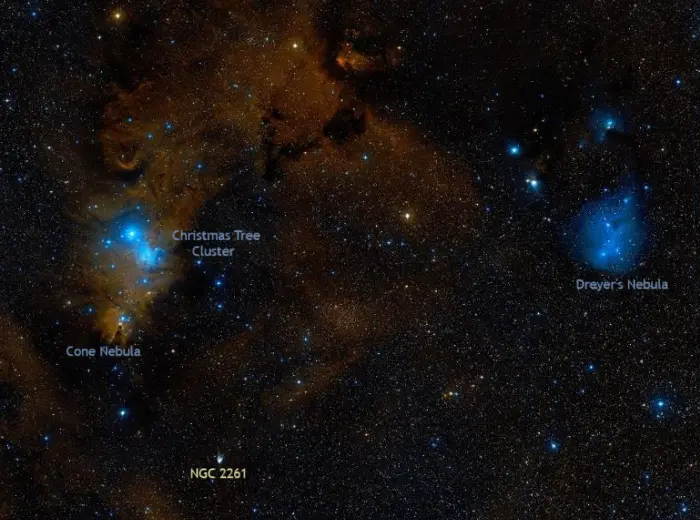
Hubble’s Variable Nebula, the Cone Nebula, the Christmas Tree Cluster and Dreyer’s Nebula, image: Wikisky (DSS)
At declination +8° 45′, Hubble’s Variable Nebula is visible from virtually anywhere for at least part of the year. The best time of the year to observe NGC 2261 and other deep sky objects in Monoceros is during the month of February, when the constellation rises higher above the horizon in the early evening.
Hubble’s Variable Nebula – NGC 2261
| Constellation | Monoceros |
| Object type | Variable nebula |
| Right ascension | 06h 39m 10s |
| Declination | +08° 45′ |
| Apparent magnitude | 9.0 |
| Apparent size | 2 arcminutes |
| Distance | 2,500 light-years (767 parsecs) |
| Names and designations | Hubble’s Nebula, Hubble’s Variable Nebula, NGC 2261, Caldwell 46, MCW 151, GN 06.36.4.02, Cederblad 83 (Ced 83), GSC 00746-00435, LBN 920, LBN 203.74+01.20; R Monocerotis, R Mon, BD+08 1427, ALS 9076, GCRV 4313, PLX 1550.00, LS VI +08 12, AAVSO 0633+08B, FMC 18, JP11 38, UBV M 341, WEB 6394, 2MASS J06390995+0844097, Gaia DR2 3326498762563125376, Gaia DR3 3326498762563125376, WDS J06392+0844AB |
Images
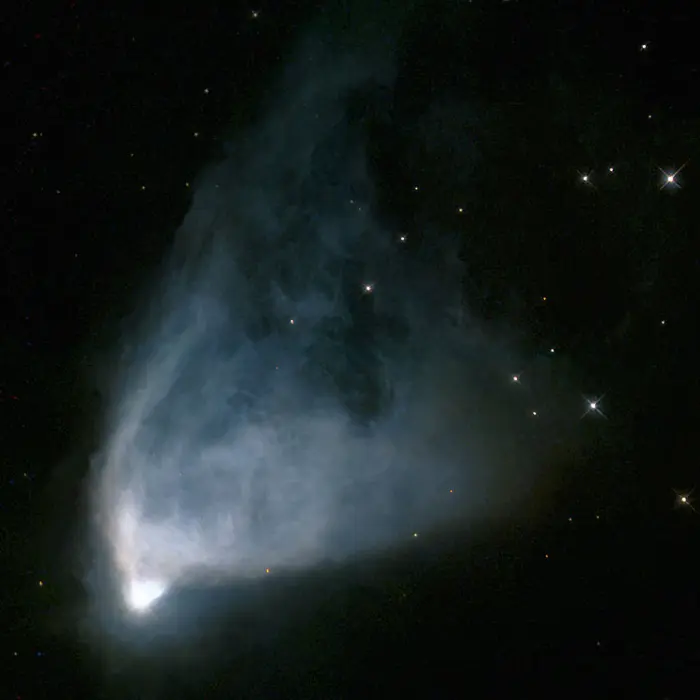
Hubble’s Variable Nebula by the Hubble Space Telescope (HST. The Hubble Heritage team made this image from observations of R Mon acquired by William Sparks (STScI), Sylvia Baggett (STScI) and collaborators. Image credit: NASA/ESA and The Hubble Heritage Team (AURA/STScI) (PD)
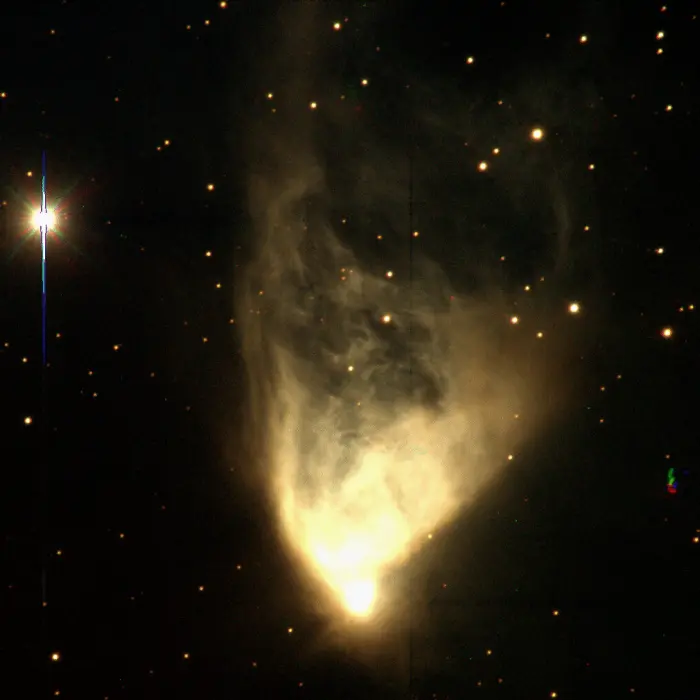
These views of NGC2261, made from a combination of red (R), green (V), and blue (B) images, are given only in false color. Image credit: Mike Pierce, Kent Honeycutt (Indiana)/WIYN/NOIRLab/NSF (CC BY 4.0)